Reasons for Corporate Collapse in Australia: ABC Learning, HIH Insurance and One Tel
VerifiedAdded on 2023/06/07
|11
|2963
|173
AI Summary
The report intends to analyse the reasons that led to the downfall of the three corporate collapses in Australia, which include ABC Learning, HIH Insurance and One Tel. The analysis provides detailed explanation of the organisations along with investigating the reasons behind their downfall. Finally, the report has shed light on APES 110 and ASIC listing rules in relation to corporate governance. Along with this, the role of liabilities in the organisations has been discussed in this report.
Contribute Materials
Your contribution can guide someone’s learning journey. Share your
documents today.
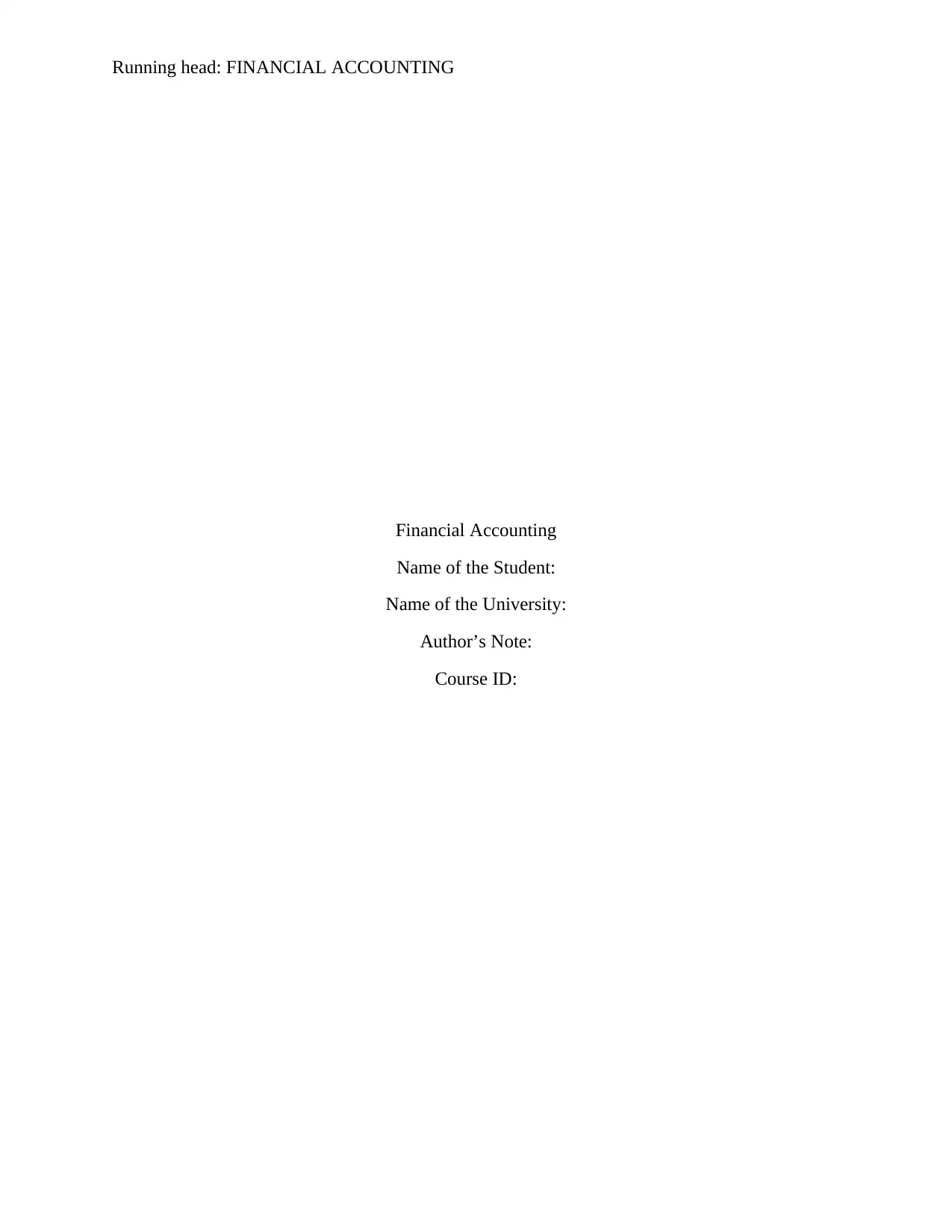
Running head: FINANCIAL ACCOUNTING
Financial Accounting
Name of the Student:
Name of the University:
Author’s Note:
Course ID:
Financial Accounting
Name of the Student:
Name of the University:
Author’s Note:
Course ID:
Secure Best Marks with AI Grader
Need help grading? Try our AI Grader for instant feedback on your assignments.
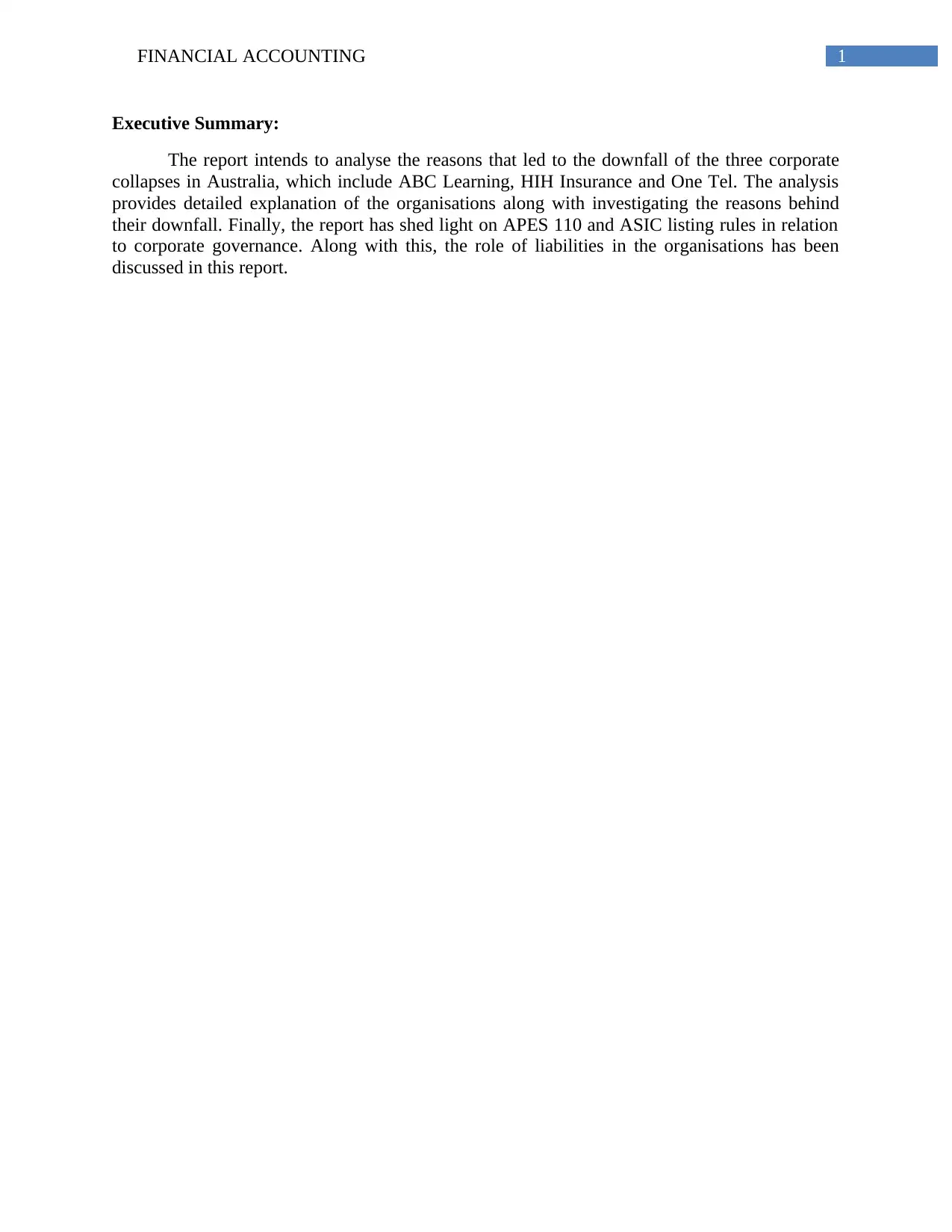
1FINANCIAL ACCOUNTING
Executive Summary:
The report intends to analyse the reasons that led to the downfall of the three corporate
collapses in Australia, which include ABC Learning, HIH Insurance and One Tel. The analysis
provides detailed explanation of the organisations along with investigating the reasons behind
their downfall. Finally, the report has shed light on APES 110 and ASIC listing rules in relation
to corporate governance. Along with this, the role of liabilities in the organisations has been
discussed in this report.
Executive Summary:
The report intends to analyse the reasons that led to the downfall of the three corporate
collapses in Australia, which include ABC Learning, HIH Insurance and One Tel. The analysis
provides detailed explanation of the organisations along with investigating the reasons behind
their downfall. Finally, the report has shed light on APES 110 and ASIC listing rules in relation
to corporate governance. Along with this, the role of liabilities in the organisations has been
discussed in this report.
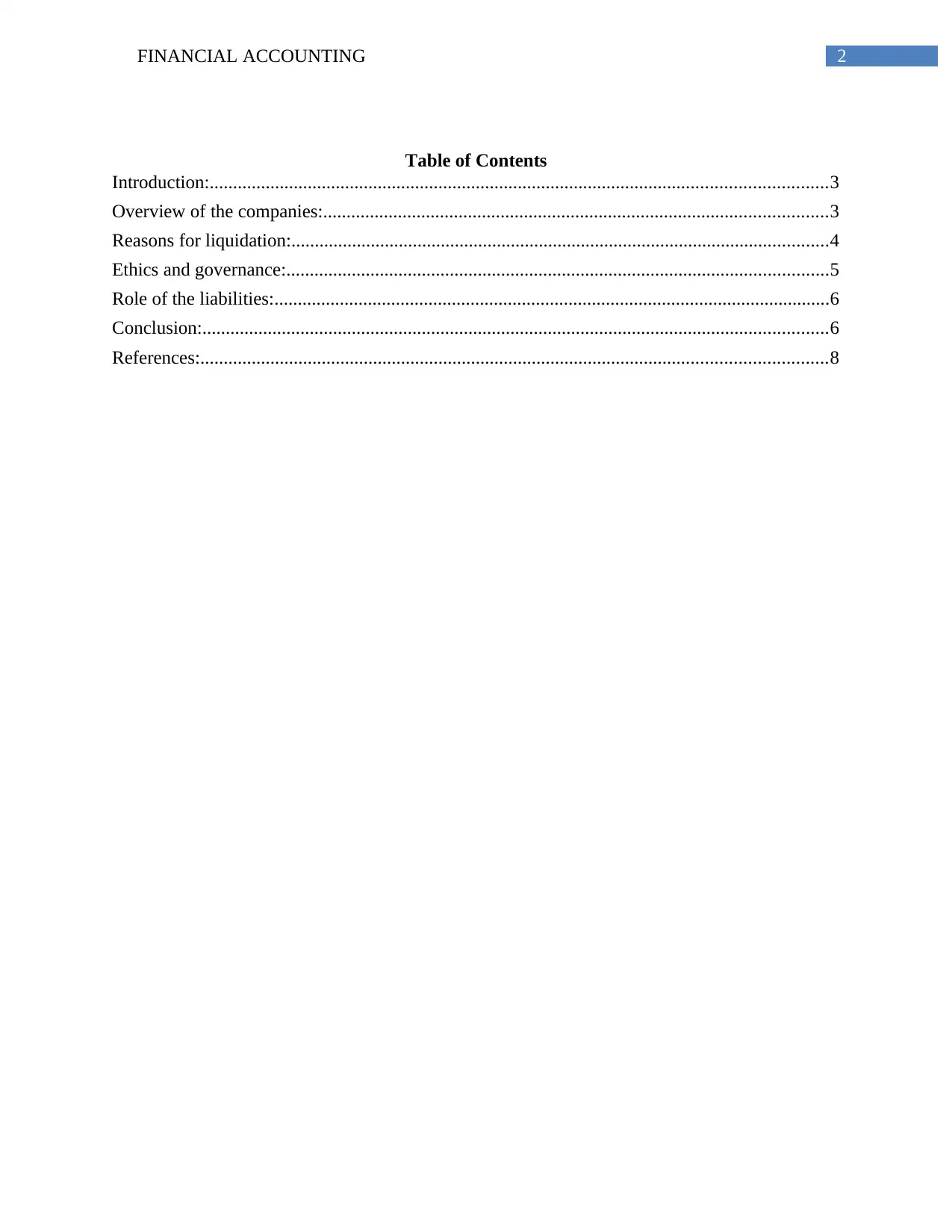
2FINANCIAL ACCOUNTING
Table of Contents
Introduction:....................................................................................................................................3
Overview of the companies:............................................................................................................3
Reasons for liquidation:...................................................................................................................4
Ethics and governance:....................................................................................................................5
Role of the liabilities:.......................................................................................................................6
Conclusion:......................................................................................................................................6
References:......................................................................................................................................8
Table of Contents
Introduction:....................................................................................................................................3
Overview of the companies:............................................................................................................3
Reasons for liquidation:...................................................................................................................4
Ethics and governance:....................................................................................................................5
Role of the liabilities:.......................................................................................................................6
Conclusion:......................................................................................................................................6
References:......................................................................................................................................8
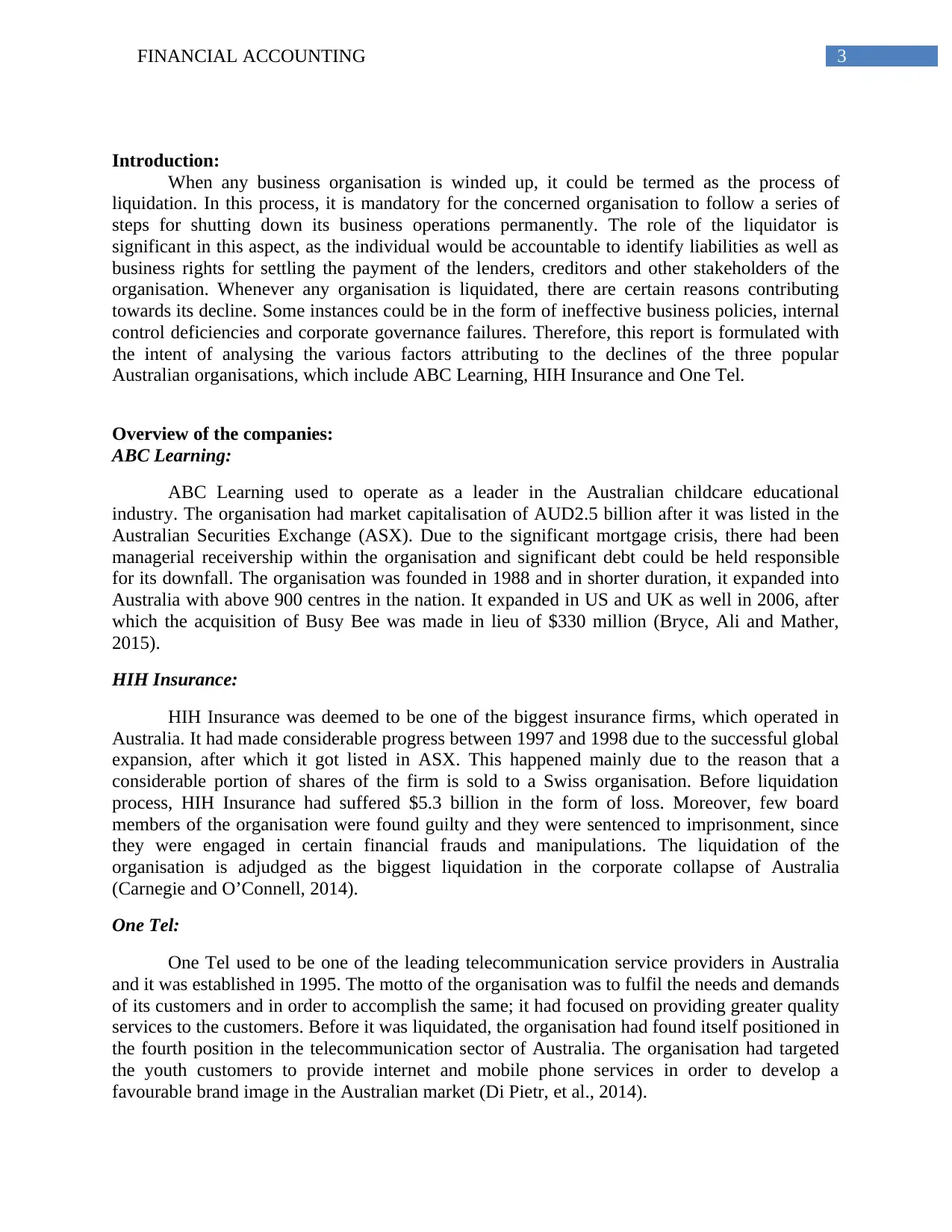
3FINANCIAL ACCOUNTING
Introduction:
When any business organisation is winded up, it could be termed as the process of
liquidation. In this process, it is mandatory for the concerned organisation to follow a series of
steps for shutting down its business operations permanently. The role of the liquidator is
significant in this aspect, as the individual would be accountable to identify liabilities as well as
business rights for settling the payment of the lenders, creditors and other stakeholders of the
organisation. Whenever any organisation is liquidated, there are certain reasons contributing
towards its decline. Some instances could be in the form of ineffective business policies, internal
control deficiencies and corporate governance failures. Therefore, this report is formulated with
the intent of analysing the various factors attributing to the declines of the three popular
Australian organisations, which include ABC Learning, HIH Insurance and One Tel.
Overview of the companies:
ABC Learning:
ABC Learning used to operate as a leader in the Australian childcare educational
industry. The organisation had market capitalisation of AUD2.5 billion after it was listed in the
Australian Securities Exchange (ASX). Due to the significant mortgage crisis, there had been
managerial receivership within the organisation and significant debt could be held responsible
for its downfall. The organisation was founded in 1988 and in shorter duration, it expanded into
Australia with above 900 centres in the nation. It expanded in US and UK as well in 2006, after
which the acquisition of Busy Bee was made in lieu of $330 million (Bryce, Ali and Mather,
2015).
HIH Insurance:
HIH Insurance was deemed to be one of the biggest insurance firms, which operated in
Australia. It had made considerable progress between 1997 and 1998 due to the successful global
expansion, after which it got listed in ASX. This happened mainly due to the reason that a
considerable portion of shares of the firm is sold to a Swiss organisation. Before liquidation
process, HIH Insurance had suffered $5.3 billion in the form of loss. Moreover, few board
members of the organisation were found guilty and they were sentenced to imprisonment, since
they were engaged in certain financial frauds and manipulations. The liquidation of the
organisation is adjudged as the biggest liquidation in the corporate collapse of Australia
(Carnegie and O’Connell, 2014).
One Tel:
One Tel used to be one of the leading telecommunication service providers in Australia
and it was established in 1995. The motto of the organisation was to fulfil the needs and demands
of its customers and in order to accomplish the same; it had focused on providing greater quality
services to the customers. Before it was liquidated, the organisation had found itself positioned in
the fourth position in the telecommunication sector of Australia. The organisation had targeted
the youth customers to provide internet and mobile phone services in order to develop a
favourable brand image in the Australian market (Di Pietr, et al., 2014).
Introduction:
When any business organisation is winded up, it could be termed as the process of
liquidation. In this process, it is mandatory for the concerned organisation to follow a series of
steps for shutting down its business operations permanently. The role of the liquidator is
significant in this aspect, as the individual would be accountable to identify liabilities as well as
business rights for settling the payment of the lenders, creditors and other stakeholders of the
organisation. Whenever any organisation is liquidated, there are certain reasons contributing
towards its decline. Some instances could be in the form of ineffective business policies, internal
control deficiencies and corporate governance failures. Therefore, this report is formulated with
the intent of analysing the various factors attributing to the declines of the three popular
Australian organisations, which include ABC Learning, HIH Insurance and One Tel.
Overview of the companies:
ABC Learning:
ABC Learning used to operate as a leader in the Australian childcare educational
industry. The organisation had market capitalisation of AUD2.5 billion after it was listed in the
Australian Securities Exchange (ASX). Due to the significant mortgage crisis, there had been
managerial receivership within the organisation and significant debt could be held responsible
for its downfall. The organisation was founded in 1988 and in shorter duration, it expanded into
Australia with above 900 centres in the nation. It expanded in US and UK as well in 2006, after
which the acquisition of Busy Bee was made in lieu of $330 million (Bryce, Ali and Mather,
2015).
HIH Insurance:
HIH Insurance was deemed to be one of the biggest insurance firms, which operated in
Australia. It had made considerable progress between 1997 and 1998 due to the successful global
expansion, after which it got listed in ASX. This happened mainly due to the reason that a
considerable portion of shares of the firm is sold to a Swiss organisation. Before liquidation
process, HIH Insurance had suffered $5.3 billion in the form of loss. Moreover, few board
members of the organisation were found guilty and they were sentenced to imprisonment, since
they were engaged in certain financial frauds and manipulations. The liquidation of the
organisation is adjudged as the biggest liquidation in the corporate collapse of Australia
(Carnegie and O’Connell, 2014).
One Tel:
One Tel used to be one of the leading telecommunication service providers in Australia
and it was established in 1995. The motto of the organisation was to fulfil the needs and demands
of its customers and in order to accomplish the same; it had focused on providing greater quality
services to the customers. Before it was liquidated, the organisation had found itself positioned in
the fourth position in the telecommunication sector of Australia. The organisation had targeted
the youth customers to provide internet and mobile phone services in order to develop a
favourable brand image in the Australian market (Di Pietr, et al., 2014).
Secure Best Marks with AI Grader
Need help grading? Try our AI Grader for instant feedback on your assignments.
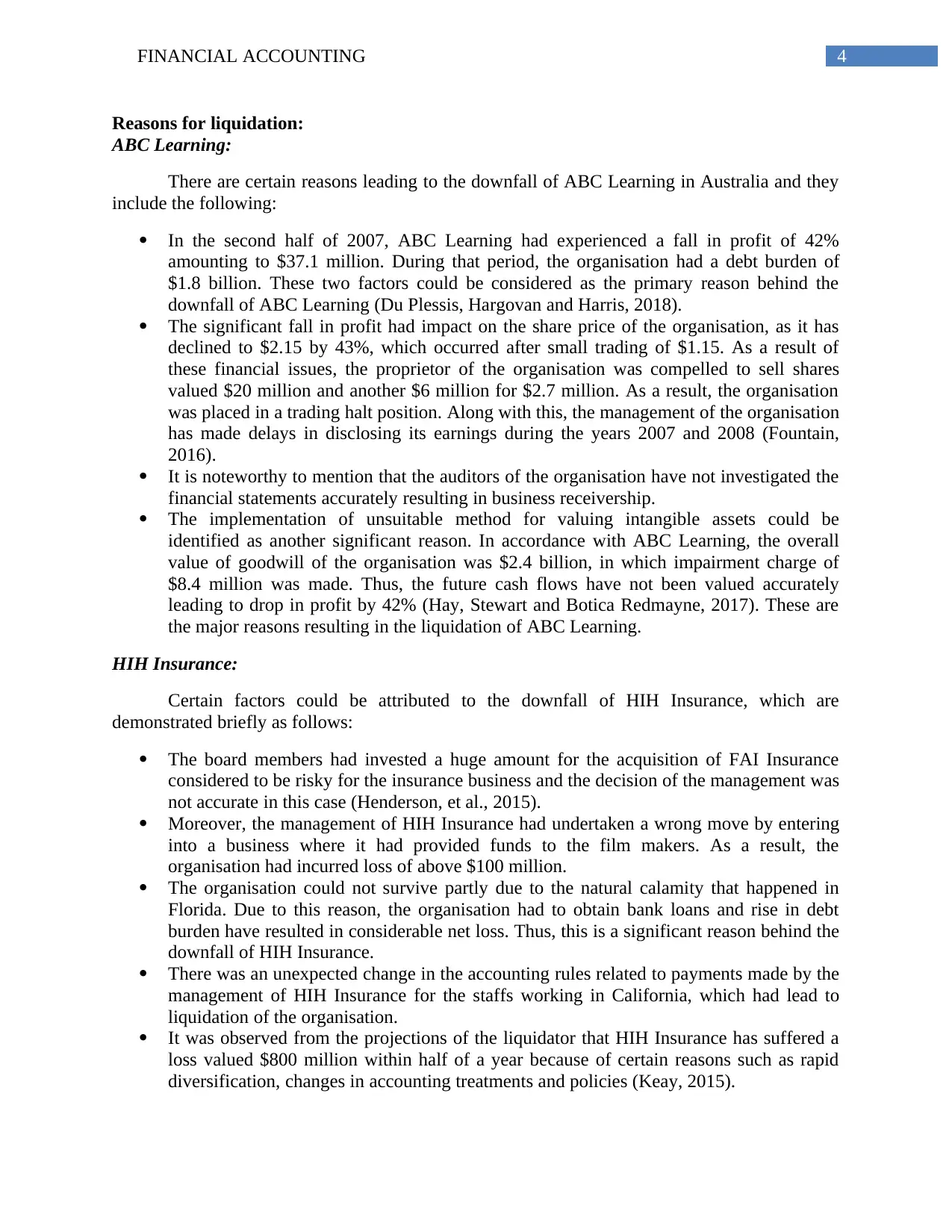
4FINANCIAL ACCOUNTING
Reasons for liquidation:
ABC Learning:
There are certain reasons leading to the downfall of ABC Learning in Australia and they
include the following:
In the second half of 2007, ABC Learning had experienced a fall in profit of 42%
amounting to $37.1 million. During that period, the organisation had a debt burden of
$1.8 billion. These two factors could be considered as the primary reason behind the
downfall of ABC Learning (Du Plessis, Hargovan and Harris, 2018).
The significant fall in profit had impact on the share price of the organisation, as it has
declined to $2.15 by 43%, which occurred after small trading of $1.15. As a result of
these financial issues, the proprietor of the organisation was compelled to sell shares
valued $20 million and another $6 million for $2.7 million. As a result, the organisation
was placed in a trading halt position. Along with this, the management of the organisation
has made delays in disclosing its earnings during the years 2007 and 2008 (Fountain,
2016).
It is noteworthy to mention that the auditors of the organisation have not investigated the
financial statements accurately resulting in business receivership.
The implementation of unsuitable method for valuing intangible assets could be
identified as another significant reason. In accordance with ABC Learning, the overall
value of goodwill of the organisation was $2.4 billion, in which impairment charge of
$8.4 million was made. Thus, the future cash flows have not been valued accurately
leading to drop in profit by 42% (Hay, Stewart and Botica Redmayne, 2017). These are
the major reasons resulting in the liquidation of ABC Learning.
HIH Insurance:
Certain factors could be attributed to the downfall of HIH Insurance, which are
demonstrated briefly as follows:
The board members had invested a huge amount for the acquisition of FAI Insurance
considered to be risky for the insurance business and the decision of the management was
not accurate in this case (Henderson, et al., 2015).
Moreover, the management of HIH Insurance had undertaken a wrong move by entering
into a business where it had provided funds to the film makers. As a result, the
organisation had incurred loss of above $100 million.
The organisation could not survive partly due to the natural calamity that happened in
Florida. Due to this reason, the organisation had to obtain bank loans and rise in debt
burden have resulted in considerable net loss. Thus, this is a significant reason behind the
downfall of HIH Insurance.
There was an unexpected change in the accounting rules related to payments made by the
management of HIH Insurance for the staffs working in California, which had lead to
liquidation of the organisation.
It was observed from the projections of the liquidator that HIH Insurance has suffered a
loss valued $800 million within half of a year because of certain reasons such as rapid
diversification, changes in accounting treatments and policies (Keay, 2015).
Reasons for liquidation:
ABC Learning:
There are certain reasons leading to the downfall of ABC Learning in Australia and they
include the following:
In the second half of 2007, ABC Learning had experienced a fall in profit of 42%
amounting to $37.1 million. During that period, the organisation had a debt burden of
$1.8 billion. These two factors could be considered as the primary reason behind the
downfall of ABC Learning (Du Plessis, Hargovan and Harris, 2018).
The significant fall in profit had impact on the share price of the organisation, as it has
declined to $2.15 by 43%, which occurred after small trading of $1.15. As a result of
these financial issues, the proprietor of the organisation was compelled to sell shares
valued $20 million and another $6 million for $2.7 million. As a result, the organisation
was placed in a trading halt position. Along with this, the management of the organisation
has made delays in disclosing its earnings during the years 2007 and 2008 (Fountain,
2016).
It is noteworthy to mention that the auditors of the organisation have not investigated the
financial statements accurately resulting in business receivership.
The implementation of unsuitable method for valuing intangible assets could be
identified as another significant reason. In accordance with ABC Learning, the overall
value of goodwill of the organisation was $2.4 billion, in which impairment charge of
$8.4 million was made. Thus, the future cash flows have not been valued accurately
leading to drop in profit by 42% (Hay, Stewart and Botica Redmayne, 2017). These are
the major reasons resulting in the liquidation of ABC Learning.
HIH Insurance:
Certain factors could be attributed to the downfall of HIH Insurance, which are
demonstrated briefly as follows:
The board members had invested a huge amount for the acquisition of FAI Insurance
considered to be risky for the insurance business and the decision of the management was
not accurate in this case (Henderson, et al., 2015).
Moreover, the management of HIH Insurance had undertaken a wrong move by entering
into a business where it had provided funds to the film makers. As a result, the
organisation had incurred loss of above $100 million.
The organisation could not survive partly due to the natural calamity that happened in
Florida. Due to this reason, the organisation had to obtain bank loans and rise in debt
burden have resulted in considerable net loss. Thus, this is a significant reason behind the
downfall of HIH Insurance.
There was an unexpected change in the accounting rules related to payments made by the
management of HIH Insurance for the staffs working in California, which had lead to
liquidation of the organisation.
It was observed from the projections of the liquidator that HIH Insurance has suffered a
loss valued $800 million within half of a year because of certain reasons such as rapid
diversification, changes in accounting treatments and policies (Keay, 2015).
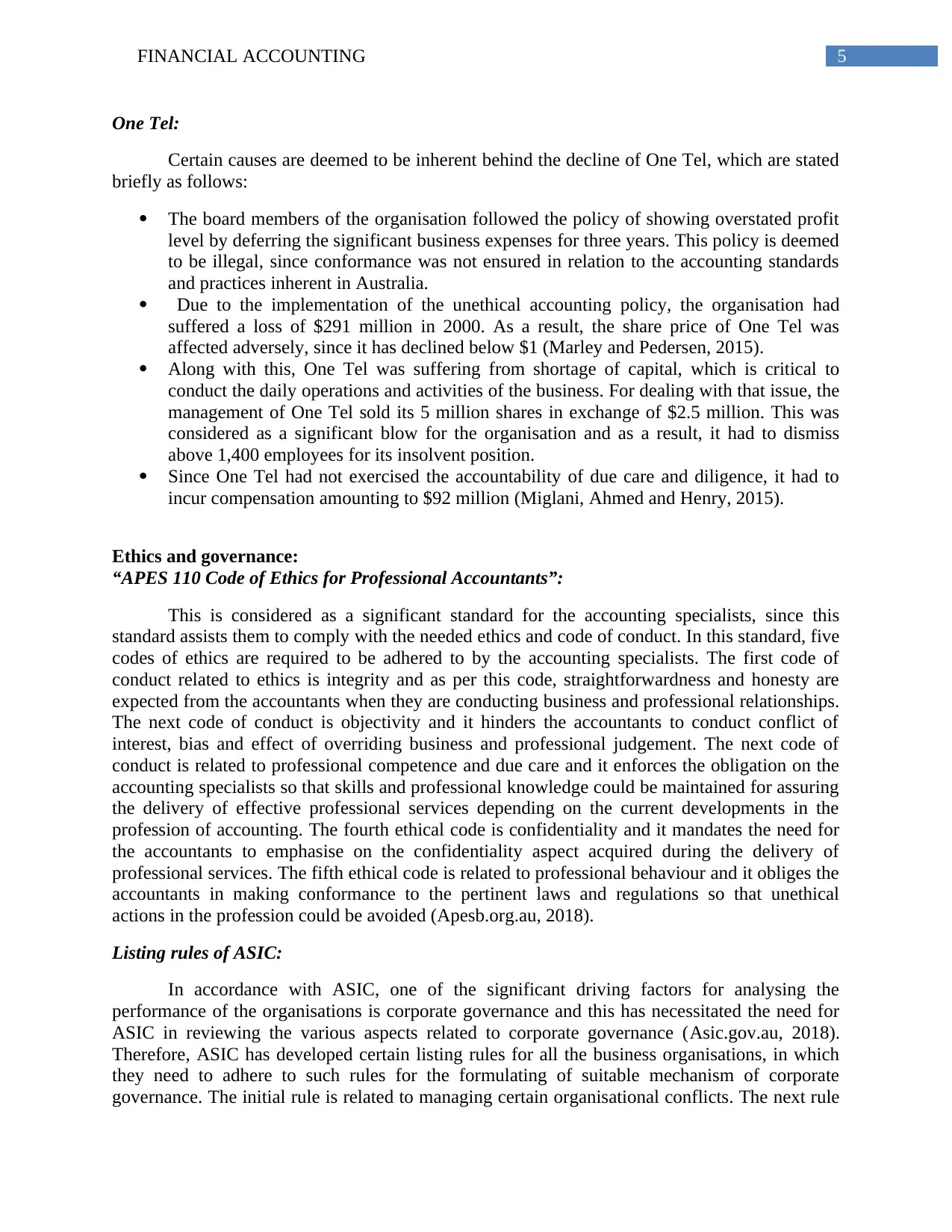
5FINANCIAL ACCOUNTING
One Tel:
Certain causes are deemed to be inherent behind the decline of One Tel, which are stated
briefly as follows:
The board members of the organisation followed the policy of showing overstated profit
level by deferring the significant business expenses for three years. This policy is deemed
to be illegal, since conformance was not ensured in relation to the accounting standards
and practices inherent in Australia.
Due to the implementation of the unethical accounting policy, the organisation had
suffered a loss of $291 million in 2000. As a result, the share price of One Tel was
affected adversely, since it has declined below $1 (Marley and Pedersen, 2015).
Along with this, One Tel was suffering from shortage of capital, which is critical to
conduct the daily operations and activities of the business. For dealing with that issue, the
management of One Tel sold its 5 million shares in exchange of $2.5 million. This was
considered as a significant blow for the organisation and as a result, it had to dismiss
above 1,400 employees for its insolvent position.
Since One Tel had not exercised the accountability of due care and diligence, it had to
incur compensation amounting to $92 million (Miglani, Ahmed and Henry, 2015).
Ethics and governance:
“APES 110 Code of Ethics for Professional Accountants”:
This is considered as a significant standard for the accounting specialists, since this
standard assists them to comply with the needed ethics and code of conduct. In this standard, five
codes of ethics are required to be adhered to by the accounting specialists. The first code of
conduct related to ethics is integrity and as per this code, straightforwardness and honesty are
expected from the accountants when they are conducting business and professional relationships.
The next code of conduct is objectivity and it hinders the accountants to conduct conflict of
interest, bias and effect of overriding business and professional judgement. The next code of
conduct is related to professional competence and due care and it enforces the obligation on the
accounting specialists so that skills and professional knowledge could be maintained for assuring
the delivery of effective professional services depending on the current developments in the
profession of accounting. The fourth ethical code is confidentiality and it mandates the need for
the accountants to emphasise on the confidentiality aspect acquired during the delivery of
professional services. The fifth ethical code is related to professional behaviour and it obliges the
accountants in making conformance to the pertinent laws and regulations so that unethical
actions in the profession could be avoided (Apesb.org.au, 2018).
Listing rules of ASIC:
In accordance with ASIC, one of the significant driving factors for analysing the
performance of the organisations is corporate governance and this has necessitated the need for
ASIC in reviewing the various aspects related to corporate governance (Asic.gov.au, 2018).
Therefore, ASIC has developed certain listing rules for all the business organisations, in which
they need to adhere to such rules for the formulating of suitable mechanism of corporate
governance. The initial rule is related to managing certain organisational conflicts. The next rule
One Tel:
Certain causes are deemed to be inherent behind the decline of One Tel, which are stated
briefly as follows:
The board members of the organisation followed the policy of showing overstated profit
level by deferring the significant business expenses for three years. This policy is deemed
to be illegal, since conformance was not ensured in relation to the accounting standards
and practices inherent in Australia.
Due to the implementation of the unethical accounting policy, the organisation had
suffered a loss of $291 million in 2000. As a result, the share price of One Tel was
affected adversely, since it has declined below $1 (Marley and Pedersen, 2015).
Along with this, One Tel was suffering from shortage of capital, which is critical to
conduct the daily operations and activities of the business. For dealing with that issue, the
management of One Tel sold its 5 million shares in exchange of $2.5 million. This was
considered as a significant blow for the organisation and as a result, it had to dismiss
above 1,400 employees for its insolvent position.
Since One Tel had not exercised the accountability of due care and diligence, it had to
incur compensation amounting to $92 million (Miglani, Ahmed and Henry, 2015).
Ethics and governance:
“APES 110 Code of Ethics for Professional Accountants”:
This is considered as a significant standard for the accounting specialists, since this
standard assists them to comply with the needed ethics and code of conduct. In this standard, five
codes of ethics are required to be adhered to by the accounting specialists. The first code of
conduct related to ethics is integrity and as per this code, straightforwardness and honesty are
expected from the accountants when they are conducting business and professional relationships.
The next code of conduct is objectivity and it hinders the accountants to conduct conflict of
interest, bias and effect of overriding business and professional judgement. The next code of
conduct is related to professional competence and due care and it enforces the obligation on the
accounting specialists so that skills and professional knowledge could be maintained for assuring
the delivery of effective professional services depending on the current developments in the
profession of accounting. The fourth ethical code is confidentiality and it mandates the need for
the accountants to emphasise on the confidentiality aspect acquired during the delivery of
professional services. The fifth ethical code is related to professional behaviour and it obliges the
accountants in making conformance to the pertinent laws and regulations so that unethical
actions in the profession could be avoided (Apesb.org.au, 2018).
Listing rules of ASIC:
In accordance with ASIC, one of the significant driving factors for analysing the
performance of the organisations is corporate governance and this has necessitated the need for
ASIC in reviewing the various aspects related to corporate governance (Asic.gov.au, 2018).
Therefore, ASIC has developed certain listing rules for all the business organisations, in which
they need to adhere to such rules for the formulating of suitable mechanism of corporate
governance. The initial rule is related to managing certain organisational conflicts. The next rule
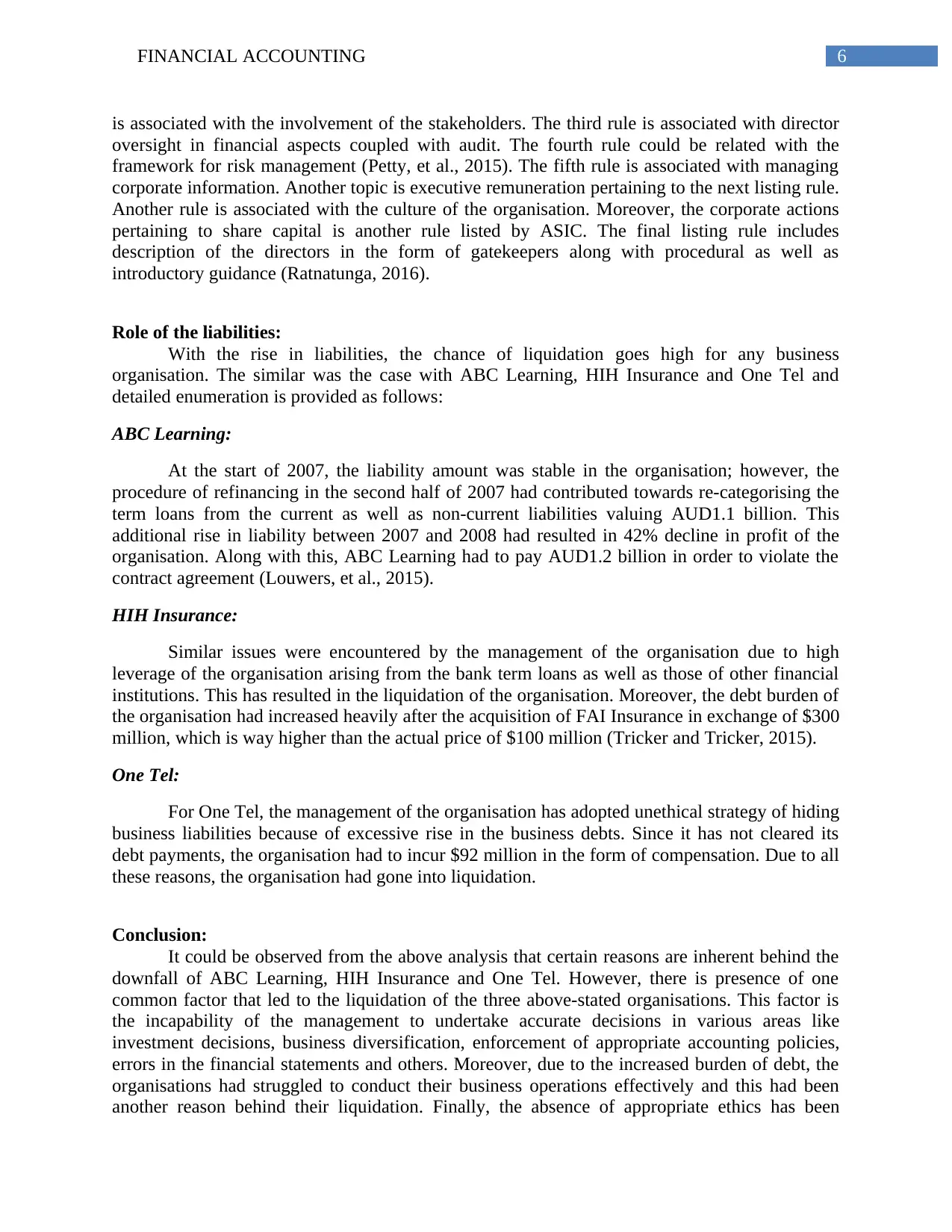
6FINANCIAL ACCOUNTING
is associated with the involvement of the stakeholders. The third rule is associated with director
oversight in financial aspects coupled with audit. The fourth rule could be related with the
framework for risk management (Petty, et al., 2015). The fifth rule is associated with managing
corporate information. Another topic is executive remuneration pertaining to the next listing rule.
Another rule is associated with the culture of the organisation. Moreover, the corporate actions
pertaining to share capital is another rule listed by ASIC. The final listing rule includes
description of the directors in the form of gatekeepers along with procedural as well as
introductory guidance (Ratnatunga, 2016).
Role of the liabilities:
With the rise in liabilities, the chance of liquidation goes high for any business
organisation. The similar was the case with ABC Learning, HIH Insurance and One Tel and
detailed enumeration is provided as follows:
ABC Learning:
At the start of 2007, the liability amount was stable in the organisation; however, the
procedure of refinancing in the second half of 2007 had contributed towards re-categorising the
term loans from the current as well as non-current liabilities valuing AUD1.1 billion. This
additional rise in liability between 2007 and 2008 had resulted in 42% decline in profit of the
organisation. Along with this, ABC Learning had to pay AUD1.2 billion in order to violate the
contract agreement (Louwers, et al., 2015).
HIH Insurance:
Similar issues were encountered by the management of the organisation due to high
leverage of the organisation arising from the bank term loans as well as those of other financial
institutions. This has resulted in the liquidation of the organisation. Moreover, the debt burden of
the organisation had increased heavily after the acquisition of FAI Insurance in exchange of $300
million, which is way higher than the actual price of $100 million (Tricker and Tricker, 2015).
One Tel:
For One Tel, the management of the organisation has adopted unethical strategy of hiding
business liabilities because of excessive rise in the business debts. Since it has not cleared its
debt payments, the organisation had to incur $92 million in the form of compensation. Due to all
these reasons, the organisation had gone into liquidation.
Conclusion:
It could be observed from the above analysis that certain reasons are inherent behind the
downfall of ABC Learning, HIH Insurance and One Tel. However, there is presence of one
common factor that led to the liquidation of the three above-stated organisations. This factor is
the incapability of the management to undertake accurate decisions in various areas like
investment decisions, business diversification, enforcement of appropriate accounting policies,
errors in the financial statements and others. Moreover, due to the increased burden of debt, the
organisations had struggled to conduct their business operations effectively and this had been
another reason behind their liquidation. Finally, the absence of appropriate ethics has been
is associated with the involvement of the stakeholders. The third rule is associated with director
oversight in financial aspects coupled with audit. The fourth rule could be related with the
framework for risk management (Petty, et al., 2015). The fifth rule is associated with managing
corporate information. Another topic is executive remuneration pertaining to the next listing rule.
Another rule is associated with the culture of the organisation. Moreover, the corporate actions
pertaining to share capital is another rule listed by ASIC. The final listing rule includes
description of the directors in the form of gatekeepers along with procedural as well as
introductory guidance (Ratnatunga, 2016).
Role of the liabilities:
With the rise in liabilities, the chance of liquidation goes high for any business
organisation. The similar was the case with ABC Learning, HIH Insurance and One Tel and
detailed enumeration is provided as follows:
ABC Learning:
At the start of 2007, the liability amount was stable in the organisation; however, the
procedure of refinancing in the second half of 2007 had contributed towards re-categorising the
term loans from the current as well as non-current liabilities valuing AUD1.1 billion. This
additional rise in liability between 2007 and 2008 had resulted in 42% decline in profit of the
organisation. Along with this, ABC Learning had to pay AUD1.2 billion in order to violate the
contract agreement (Louwers, et al., 2015).
HIH Insurance:
Similar issues were encountered by the management of the organisation due to high
leverage of the organisation arising from the bank term loans as well as those of other financial
institutions. This has resulted in the liquidation of the organisation. Moreover, the debt burden of
the organisation had increased heavily after the acquisition of FAI Insurance in exchange of $300
million, which is way higher than the actual price of $100 million (Tricker and Tricker, 2015).
One Tel:
For One Tel, the management of the organisation has adopted unethical strategy of hiding
business liabilities because of excessive rise in the business debts. Since it has not cleared its
debt payments, the organisation had to incur $92 million in the form of compensation. Due to all
these reasons, the organisation had gone into liquidation.
Conclusion:
It could be observed from the above analysis that certain reasons are inherent behind the
downfall of ABC Learning, HIH Insurance and One Tel. However, there is presence of one
common factor that led to the liquidation of the three above-stated organisations. This factor is
the incapability of the management to undertake accurate decisions in various areas like
investment decisions, business diversification, enforcement of appropriate accounting policies,
errors in the financial statements and others. Moreover, due to the increased burden of debt, the
organisations had struggled to conduct their business operations effectively and this had been
another reason behind their liquidation. Finally, the absence of appropriate ethics has been
Paraphrase This Document
Need a fresh take? Get an instant paraphrase of this document with our AI Paraphraser
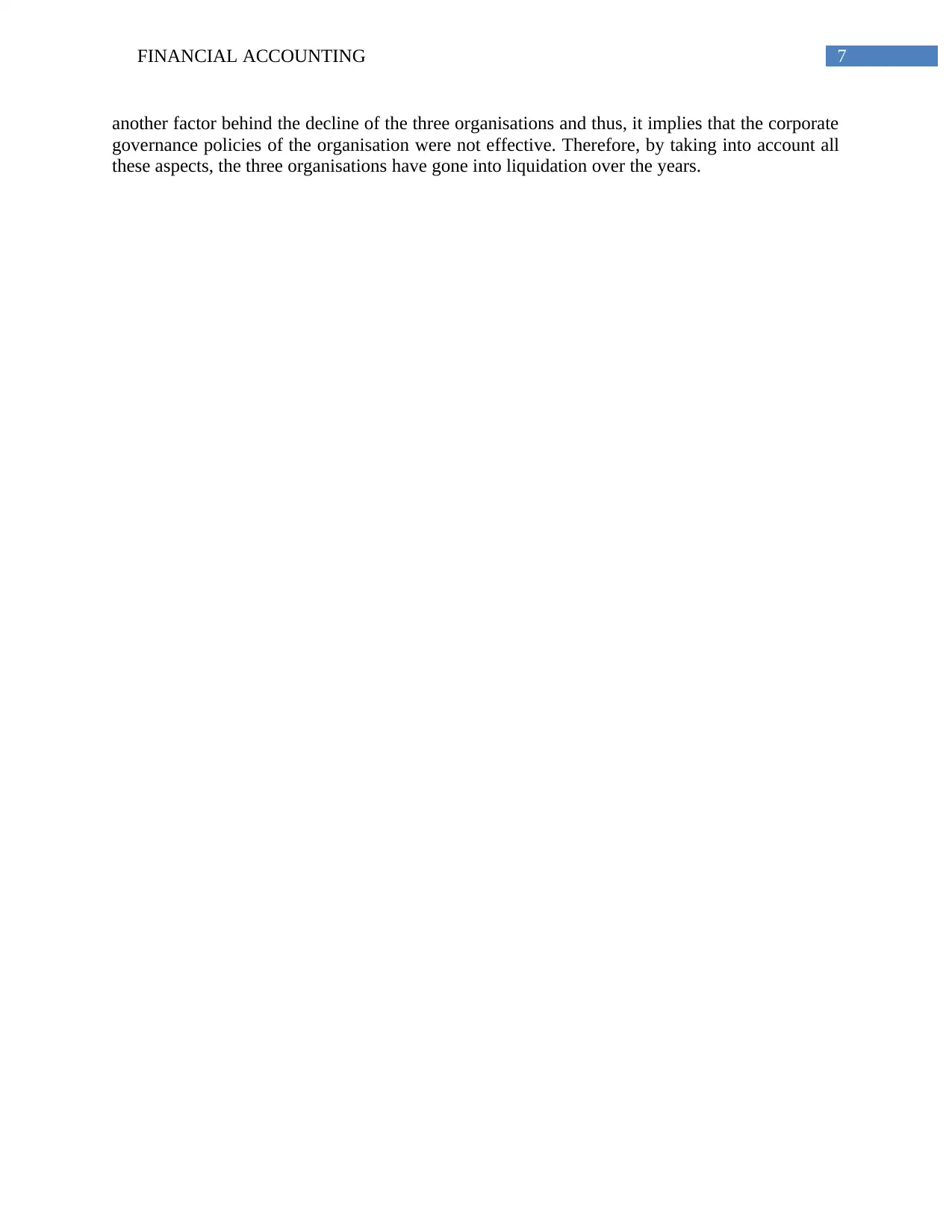
7FINANCIAL ACCOUNTING
another factor behind the decline of the three organisations and thus, it implies that the corporate
governance policies of the organisation were not effective. Therefore, by taking into account all
these aspects, the three organisations have gone into liquidation over the years.
another factor behind the decline of the three organisations and thus, it implies that the corporate
governance policies of the organisation were not effective. Therefore, by taking into account all
these aspects, the three organisations have gone into liquidation over the years.
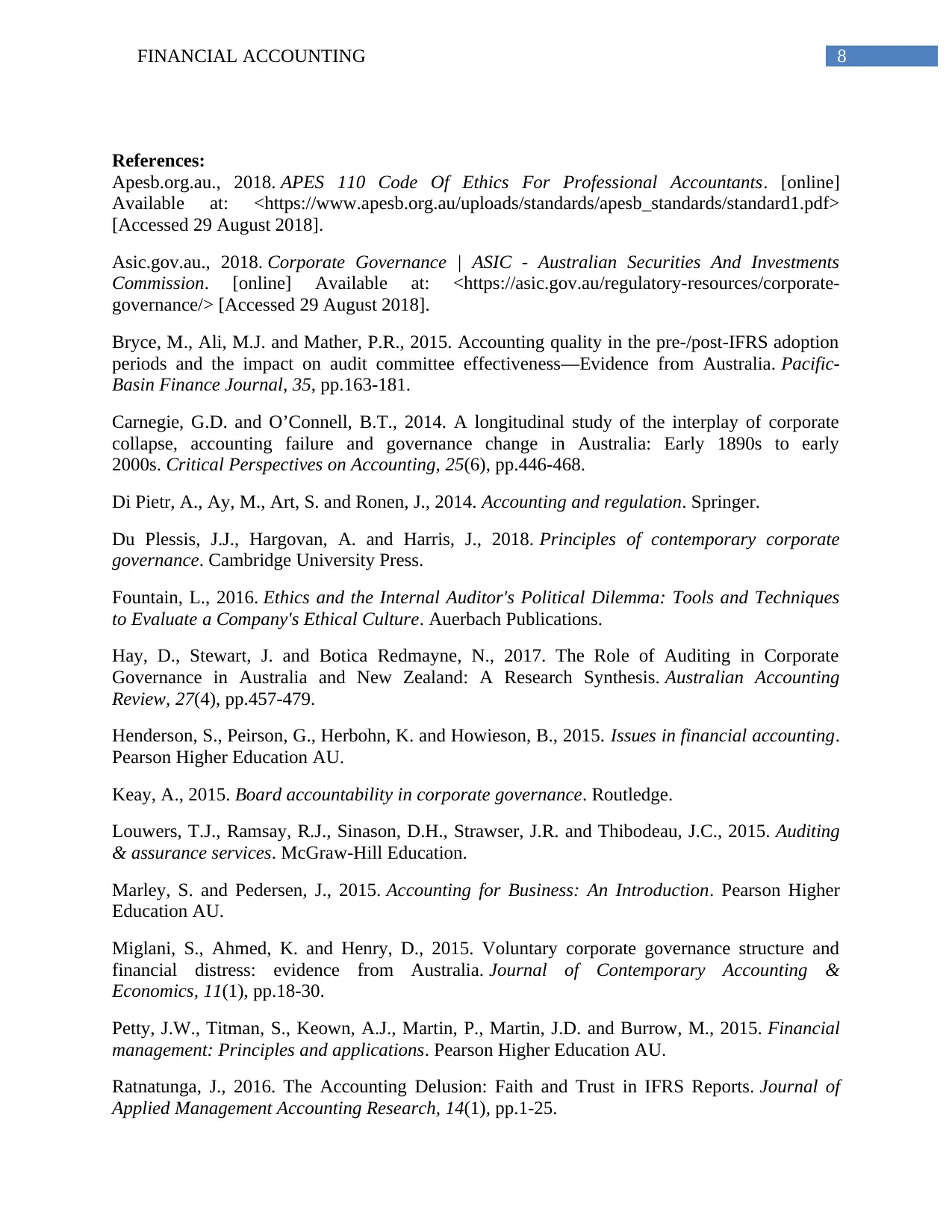
8FINANCIAL ACCOUNTING
References:
Apesb.org.au., 2018. APES 110 Code Of Ethics For Professional Accountants. [online]
Available at: <https://www.apesb.org.au/uploads/standards/apesb_standards/standard1.pdf>
[Accessed 29 August 2018].
Asic.gov.au., 2018. Corporate Governance | ASIC - Australian Securities And Investments
Commission. [online] Available at: <https://asic.gov.au/regulatory-resources/corporate-
governance/> [Accessed 29 August 2018].
Bryce, M., Ali, M.J. and Mather, P.R., 2015. Accounting quality in the pre-/post-IFRS adoption
periods and the impact on audit committee effectiveness—Evidence from Australia. Pacific-
Basin Finance Journal, 35, pp.163-181.
Carnegie, G.D. and O’Connell, B.T., 2014. A longitudinal study of the interplay of corporate
collapse, accounting failure and governance change in Australia: Early 1890s to early
2000s. Critical Perspectives on Accounting, 25(6), pp.446-468.
Di Pietr, A., Ay, M., Art, S. and Ronen, J., 2014. Accounting and regulation. Springer.
Du Plessis, J.J., Hargovan, A. and Harris, J., 2018. Principles of contemporary corporate
governance. Cambridge University Press.
Fountain, L., 2016. Ethics and the Internal Auditor's Political Dilemma: Tools and Techniques
to Evaluate a Company's Ethical Culture. Auerbach Publications.
Hay, D., Stewart, J. and Botica Redmayne, N., 2017. The Role of Auditing in Corporate
Governance in Australia and New Zealand: A Research Synthesis. Australian Accounting
Review, 27(4), pp.457-479.
Henderson, S., Peirson, G., Herbohn, K. and Howieson, B., 2015. Issues in financial accounting.
Pearson Higher Education AU.
Keay, A., 2015. Board accountability in corporate governance. Routledge.
Louwers, T.J., Ramsay, R.J., Sinason, D.H., Strawser, J.R. and Thibodeau, J.C., 2015. Auditing
& assurance services. McGraw-Hill Education.
Marley, S. and Pedersen, J., 2015. Accounting for Business: An Introduction. Pearson Higher
Education AU.
Miglani, S., Ahmed, K. and Henry, D., 2015. Voluntary corporate governance structure and
financial distress: evidence from Australia. Journal of Contemporary Accounting &
Economics, 11(1), pp.18-30.
Petty, J.W., Titman, S., Keown, A.J., Martin, P., Martin, J.D. and Burrow, M., 2015. Financial
management: Principles and applications. Pearson Higher Education AU.
Ratnatunga, J., 2016. The Accounting Delusion: Faith and Trust in IFRS Reports. Journal of
Applied Management Accounting Research, 14(1), pp.1-25.
References:
Apesb.org.au., 2018. APES 110 Code Of Ethics For Professional Accountants. [online]
Available at: <https://www.apesb.org.au/uploads/standards/apesb_standards/standard1.pdf>
[Accessed 29 August 2018].
Asic.gov.au., 2018. Corporate Governance | ASIC - Australian Securities And Investments
Commission. [online] Available at: <https://asic.gov.au/regulatory-resources/corporate-
governance/> [Accessed 29 August 2018].
Bryce, M., Ali, M.J. and Mather, P.R., 2015. Accounting quality in the pre-/post-IFRS adoption
periods and the impact on audit committee effectiveness—Evidence from Australia. Pacific-
Basin Finance Journal, 35, pp.163-181.
Carnegie, G.D. and O’Connell, B.T., 2014. A longitudinal study of the interplay of corporate
collapse, accounting failure and governance change in Australia: Early 1890s to early
2000s. Critical Perspectives on Accounting, 25(6), pp.446-468.
Di Pietr, A., Ay, M., Art, S. and Ronen, J., 2014. Accounting and regulation. Springer.
Du Plessis, J.J., Hargovan, A. and Harris, J., 2018. Principles of contemporary corporate
governance. Cambridge University Press.
Fountain, L., 2016. Ethics and the Internal Auditor's Political Dilemma: Tools and Techniques
to Evaluate a Company's Ethical Culture. Auerbach Publications.
Hay, D., Stewart, J. and Botica Redmayne, N., 2017. The Role of Auditing in Corporate
Governance in Australia and New Zealand: A Research Synthesis. Australian Accounting
Review, 27(4), pp.457-479.
Henderson, S., Peirson, G., Herbohn, K. and Howieson, B., 2015. Issues in financial accounting.
Pearson Higher Education AU.
Keay, A., 2015. Board accountability in corporate governance. Routledge.
Louwers, T.J., Ramsay, R.J., Sinason, D.H., Strawser, J.R. and Thibodeau, J.C., 2015. Auditing
& assurance services. McGraw-Hill Education.
Marley, S. and Pedersen, J., 2015. Accounting for Business: An Introduction. Pearson Higher
Education AU.
Miglani, S., Ahmed, K. and Henry, D., 2015. Voluntary corporate governance structure and
financial distress: evidence from Australia. Journal of Contemporary Accounting &
Economics, 11(1), pp.18-30.
Petty, J.W., Titman, S., Keown, A.J., Martin, P., Martin, J.D. and Burrow, M., 2015. Financial
management: Principles and applications. Pearson Higher Education AU.
Ratnatunga, J., 2016. The Accounting Delusion: Faith and Trust in IFRS Reports. Journal of
Applied Management Accounting Research, 14(1), pp.1-25.
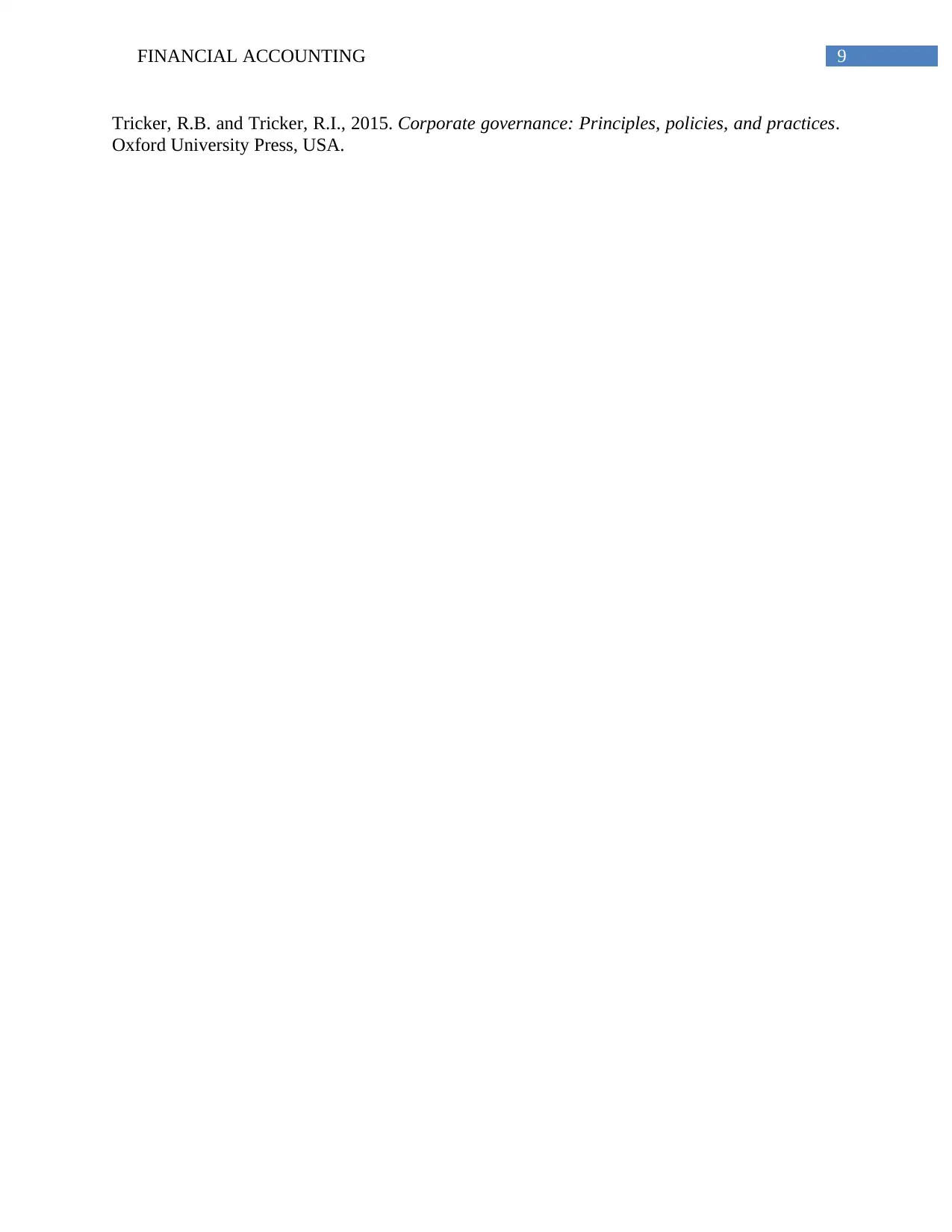
9FINANCIAL ACCOUNTING
Tricker, R.B. and Tricker, R.I., 2015. Corporate governance: Principles, policies, and practices.
Oxford University Press, USA.
Tricker, R.B. and Tricker, R.I., 2015. Corporate governance: Principles, policies, and practices.
Oxford University Press, USA.
Secure Best Marks with AI Grader
Need help grading? Try our AI Grader for instant feedback on your assignments.

10FINANCIAL ACCOUNTING
1 out of 11
Related Documents
Your All-in-One AI-Powered Toolkit for Academic Success.
+13062052269
info@desklib.com
Available 24*7 on WhatsApp / Email
![[object Object]](/_next/static/media/star-bottom.7253800d.svg)
Unlock your academic potential
© 2024 | Zucol Services PVT LTD | All rights reserved.





